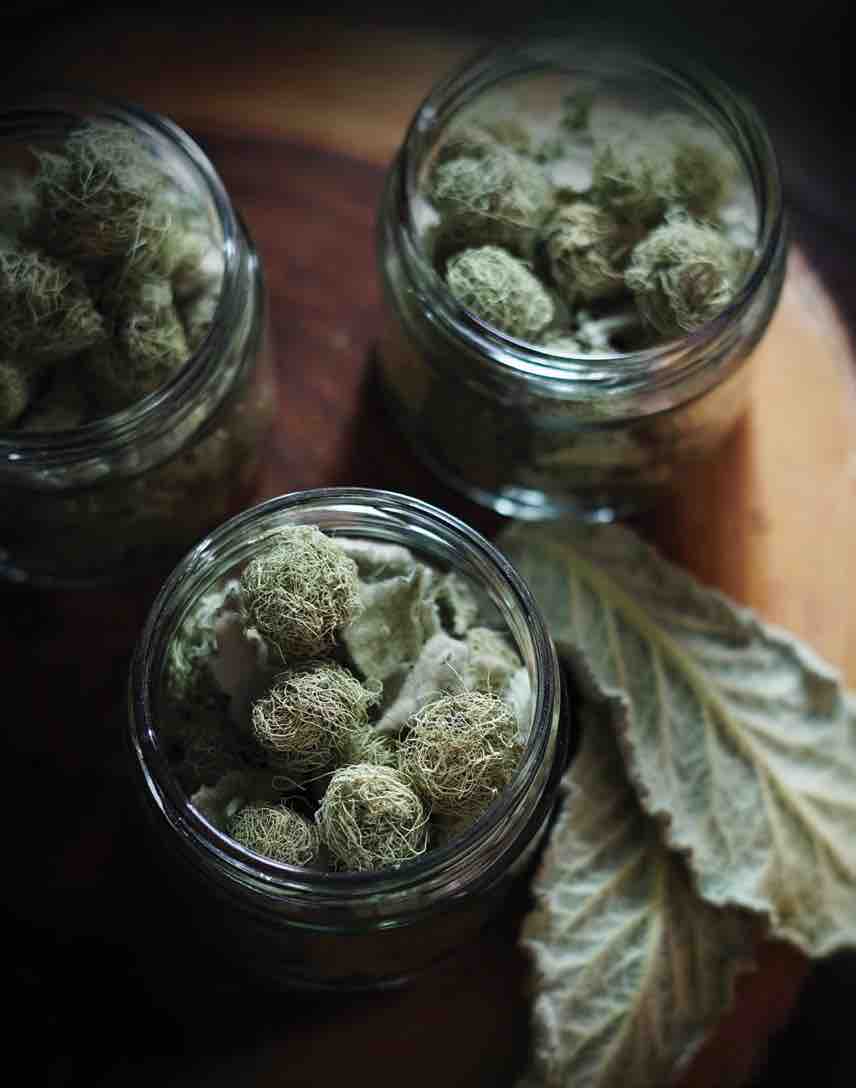PHOTOGRAPHY BY RAINSTITCHER @rainstitcher
It’s okay to be sensitive, you know. Most exceptionally beautiful things are, my dear. Take the beautiful Lobaria pulmonaria that graces my teapot and hangs from my hair. It may look tough like dragon’s skin, but it thrives only in the cleanest of forests. Its presence here is a sign that this is a place where the air is pure. Here, have a cup brewed from the herbs in these woods. It will enliven you.
You don’t need to harden yourself to the world, darling. Perhaps the world is simply too harsh for you. Some of us seek out clearer spaces and calmer lives while others thrive in the chaos. Neither path is wrong. It’s harmful only if it’s the wrong path for you.
Are you easily hurt or overwhelmed? Are you particularly in tune with the burdens of others? Do you pay attention to the little details that so many others seem to miss? Believe it or not, you are just like me. Well, minus the chlorophyllous complexion, of course. The calmness you feel in my presence is a result of my own greatest strength: softness. It takes great bravery to hold onto that precious softness in the face of the external chaos and pressures of the world, but I can see that spark in your eyes. You are strong enough to do it. Protect it like the soft and vulnerable treasure it is. Hold it close and whisper kind things to it. It won’t always be easy, but it will be worth it.
And when the world starts to feel like too much and you need a break, you are always welcome in my green cathedral. The mosses will cushion you. The trees will shelter you. And my voice will always be but a whisper away.

LUNGS OF THE FOREST
Lichens are known as the lungs of the forest both because they indicate that the air is pure and because several types can aid in supporting our lungs as well. Many people mistake lichens for a kind of plant, but they are actually a symbiosis of fungi and algae. If you decide to forage your own, keep in mind that lichens grow very slowly and are an important part of the forest ecosystem, so try to use only the lichens that have fallen to the ground on broken branches. If you do harvest from trees, do so carefully and sparingly. As with any wild plant, fungi, or lichen, make sure you are 100 percent sure of its identification before you gather any. You should also consult with your doctor before trying any new herbal remedy.
Lungwort (Lobaria pulmonaria) is named both for its lung-like appearance and for its long history of being used to treat ailments like pneumonia or asthma. It is typically taken as an infusion in hot water, which can then be sipped like tea or inhaled as a facial steam to help clear out gunky lungs. It’s a lovely bright green and has a distinctive texture that reminds me of dragon skin.
Usnea (Usnea spp.) This silvery lichen is also known for its effect on the lungs. I love foraging for usnea since the identification between it and similarly colored lichens is so fun! True usnea has a tiny white elastic thread inside the lichen’s sheath. Gently breaking the larger fibers apart will reveal it, and it’s even more dramatic if the lichen is wet. Usnea is fairly common throughout the American West and typically grows in clean, slightly damp areas of the forest on conifer trees. It’s a wonderful support for respiratory ailments and can be taken for acute symptoms or as a general tonic. Its constituents are alcohol-soluble, so the most potent preparations of usnea are tinctures. That said, it’s still effective in water infusions as well.
Turkey tail (Trametes versicolor) This is a fungus rather than a lichen, but it is worth including in this list for its immune-boosting benefits. While turkey-tail mushrooms aren’t known specifically for their effect on the lungs, they are particularly powerful at strengthening the immune system and assisting your body in fighting off infections. These mushrooms are flat, fan-shaped, and often striped with many colors, sometimes including blue and red. They grow on deadwood, particularly in damp regions. They’ve been used for thousands of years to treat many ailments, including coughs and breathing difficulties.
Mullein (Verbascum thapsus) This is a plant, but I’ve included it for its respiratory benefits. It makes a great addition to a lung-supporting tea or tincture. I always think of this plant as “mama mullein” because its presence is so soothing to me. Mullein is one of the first plants to grow in disturbed soil (like a construction zone or burned area), and it helps prepare the scene for many more plant friends. With such soft leaves and deep veins, mullein turns dewdrops into sparkling diamonds. Mullein is a beautiful pioneer. The most remarkable thing about this familiar plant is its ability to help with lung-related issues. The herbalist Darcy Williamson told me that she’s seen rolled-up mullein leaves smoked like a cigarette as an emergency stand-in for an inhaler during asthma attacks she witnessed while on backcountry expeditions where emergency care wasn’t available. (Of course if you have asthma, you should definitely use your inhaler—this is for emergencies only!) Mullein is also a common addition to herbal smoking blends for its soothing nature. That said, you don’t have to smoke mullein to get its benefits; a safer way to consume it is to brew it as a tea and then strain really well through a clean cloth to ensure none of its little fibers get into your digestive system, as they can be irritating.
To make a tea: Blending any combination of these four foraged ingredients together creates a great tonic for respiratory ailments. First, make sure everything is completely dry. I like to roll the usnea into little balls so it mixes in with shredded dried mullein or crumbled lungwort a little more neatly. The resulting tea will have a strong earthy flavor, so feel free to add in some other flavors as well! I would recommend mint (for soothing the stomach), elderflower (for reducing the temperature of a fever), or chai spices (because they are warming and taste delicious). To brew, cover about a tablespoon of the mixture in boiling water and steep for 10 minutes. Strain well through fabric to remove any hairs, then reheat and stir in a little honey if you’d like. Sip slowly and picture all of that foresty fresh-air goodness heading down to your lungs as you drink it. This tea can be drunk regularly through the season to act as a tonic for those with asthma or chronic respiratory ailments, or it can be consumed at the onset of respiratory complaints like coughs.




































[…] The Lady Lichen […]